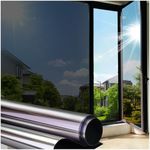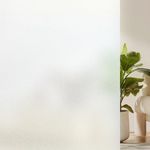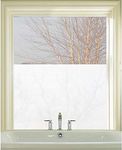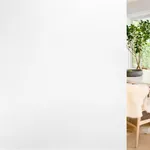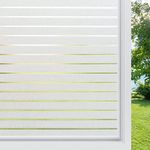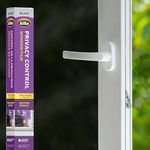Buying Guide for the Best Window Film For Privacy
Choosing the right window film for privacy can make a big difference in how comfortable and secure you feel in your space. Window films come in various types and offer different levels of privacy, light control, and appearance. Before making a decision, think about where you want to use the film (like bathrooms, bedrooms, or offices), how much privacy you need during the day and night, and whether you want to keep natural light coming in. Understanding the key features will help you pick a film that fits your needs and style.Privacy LevelPrivacy level refers to how much the film blocks the view from outside while still allowing you to see out or let light in. Some films offer complete privacy, making it impossible to see through from either side, while others provide partial privacy, blurring shapes and movements. If you need total privacy for spaces like bathrooms, choose a film labeled as 'frosted' or 'blackout.' For living rooms or offices where you want some light and a view, a lighter or patterned film may be better. Think about the room’s purpose and how much seclusion you want when picking the privacy level.
Light TransmissionLight transmission is about how much natural light the film lets through your window. Films with high light transmission keep rooms bright but may offer less privacy, while those with low light transmission make spaces dimmer but provide more seclusion. If you want to maintain a sunny atmosphere, look for films that mention high light transmission or 'daylight' in their description. For bedrooms or media rooms where you want less light, a lower transmission film is suitable. Consider how much daylight you want in the room when choosing this feature.
Appearance and StyleWindow films come in various styles, such as frosted, mirrored, stained glass, or decorative patterns. The appearance affects both the look of your space and the level of privacy. Frosted and etched styles are classic for bathrooms and offices, while decorative or stained glass films can add a design element to living areas. Mirrored films reflect the outside during the day, offering privacy and a modern look. Think about your room’s decor and whether you want the film to blend in or stand out as a feature.
Application MethodThe application method describes how the film is installed on your window. Some films are static cling, which means they stick without adhesive and can be easily repositioned or removed. Others use adhesive for a more permanent hold. Static cling films are great for renters or those who want to change styles often, while adhesive films are better for long-term use. Consider how long you plan to keep the film and whether you want the option to remove or move it when making your choice.
UV ProtectionUV protection refers to the film’s ability to block harmful ultraviolet rays from the sun. This is important because UV rays can fade furniture, flooring, and artwork over time. Some privacy films also offer high UV blocking, which helps protect your interiors and can make your home more comfortable. If you have valuable furnishings or want to reduce sun damage, look for films that mention UV protection or a high percentage of UV blocking.
Heat ControlHeat control is about how much the film helps regulate the temperature by blocking solar heat. Some privacy films are designed to reflect heat, keeping rooms cooler in the summer and potentially lowering energy costs. If your windows get a lot of direct sunlight and your room tends to get hot, consider a film with heat control properties. If temperature isn’t a concern, you can focus more on privacy and style.


